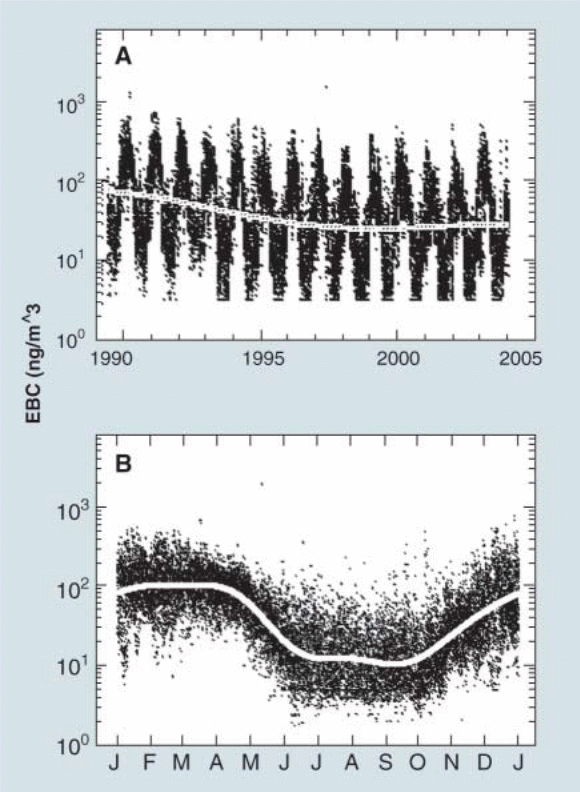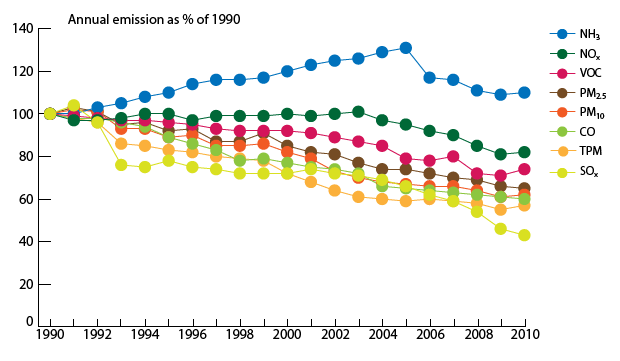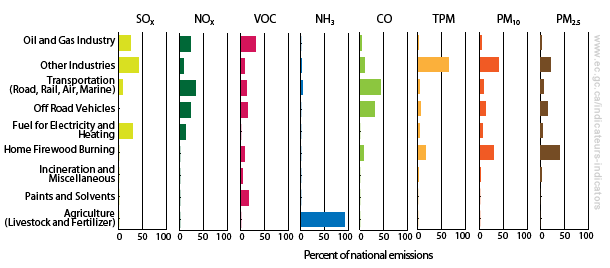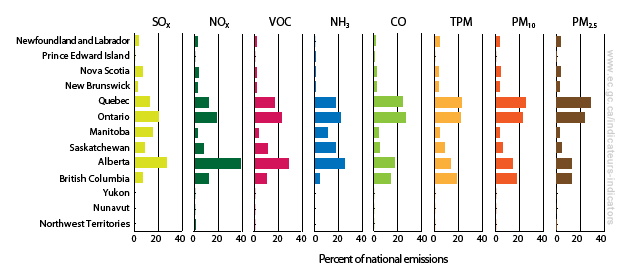Introduction
By definition, haze is an atmospheric aerosol that cumulatively concentrates to a visible status. The aggregating particles are minute and hardly invisible; however are able to cause scene distortion and limit the visual range.
According to the manual of codes by the World Meteorological Organization, haze develop from volcanic ash, smoke, dust, mist, sand, steam fog, ice fog as well as snow. Often, haze forms in relatively dry air when dust and smoke particles accumulate.
Laws and Regulations
Atmospheric emissions are the precursors for most haze pollutants. The federal government passed into law the ambient air quality guidelines in 1971 via the Clean Air Act (now CEPA). The legislation is the oldest of its kind and empowers the national government to initiate programs relating to air pollution assessment; set air quality objectives and set standards linked to the source.
Chronologically, the provincial governments were the first to introduce air quality regulations there after the federal government followed suit. Ontario was the first to describe air pollution standards in 1963, under the Air Pollution Control Act.
The legislation sets the maximum concentrations for 13 substances released by stationary sources of pollution. Other provinces that have applied regulation on the point of impingement concentrations are Manitoba, Newfoundland and Labrador.
Recent regulations that relate to air quality were provided through the introduction of National Ambient Air Quality Objectives (NAAQOs) and Canada Wide Standards at provincial and federal government levels. Often, provincial governments have air standards and objectives that reflect the national ones.
NAAQOs objectives set targets on risk towards key biological receptors; while, the Canadian Wide Standards put into perspective relatively more substances and metrics of assessments.
Additionally, there is a proposal to introduce emission standards through the Canadian Ambient Air Quality Standards, Air Management Zones and Base-Level Industrial Standards. The Canadian Wide Standards set limits for particulate matter (PM2.5) and ozone at averages of 30μg/m3 over a 24-hour and 65 ppb over an 8-hour.
Towards the end of 2010, the US and Canada agreed under the Ozone Annex to lower trans-boundary smog. This led to a 44% reduction of NOx. Both Quebec and Ontario that lie within the Industrial heartlands of Canada were set to have emission cuts.
By 2007, the annual cap of 39 kilotons of NOx for central and southern Ontario and 5 kilotons for Quebec. The Canadian government has provided money to support electricity generation through fossil fuel.
The Motor Vehicle Safety Act (under the CEPA) sets emission limits for motor vehicles for different pollutant such as CO, NOX as well as hydrocarbons. Policies on vehicle emission in Canada and the US depend on technological advances to lower pollutant release such as the CAF standards of Canada.
The realization that electric plants among other industrial establishments in North America and Europe were leading emitters of precursors of pollutants like sulfur dioxide motivated the signing of multilateral agreements.
The US and Canada have made an agreement with Europe such as the Convention on Long-Range Trans-boundary Air Pollution established in 1979 to limit the trans-boundary release of acid rain precursors. Thereafter, US and Canada have not signed the succeeding protocols agreed in Europe on the same.
The British introduced the Clean Air Act as a national legislation in 1956 and the US Congress followed suit in 1963. The US Environmental Protection Agency established the Regional Haze Rule to aid in lowering the national anthropogenic pollutant releases intended to improve linear visibility in wilderness between 2004-18 duration that will culminate to a natural visibility condition status by 2064 (Park et al. 5405).
Air Pollution and the Current Situation (in particular The Arctic Haze Phenomenon)
Quinn et al. (99) explain that Alaskan Arctic and Canada have for a half century experienced haze of unknown origin. The initial perception of its origin attributed to either dust blowing from the riverbeds or open ice seeding ice crystals.
Chemical analysis led to reveal its anthropogenic origins (Yalcin and Wake 4487). The haze comprised to a greater extent sulfate and particulate organic matter (Singh et al. 3). Other components like NOX species, ammonium, dust and black carbon were small amounts.
The presence of heavy metals gave the indications of industrial emissions. The initial measurement of the haze involved a handheld sunphotometer from an aircraft that flew vertically across Alaska. The realization of anthropogenic sources prompted the Europe and North America to convene in 1978 the Arctic Air Chemistry Symposium in Norway to agree on a concerted effort towards measurements.
Aerial measurements since in the 1980s revealed that haze existed in the lowest 5km of the atmosphere with its highs at the lowest 2km. The haze pollutants remain consistent throughout the season.
Quinn et al. (100) note that recent revelations show that natural climate variability influence inter-annual changes in levels of Arctic haze. The North Atlantic Oscillation has a positive phase leading to rise in concentrations of haze resulting from pollutants from North America and Europe.
According to Law and Stohl (1537), within a transport time span of 10 days, there was a revelation that stratospheric air-masses contributed a fifth (within a range of 3 to 5km), but close to sea level and at winter this declined to 1-0.5 percent. Asian dust contributes to haze in British Columbia, Canada (McKendry et al. 18361).
Monitoring Fluctuations of Arctic Haze Precursors
The seasonal cycle for Arctic haze reaches its climax towards the end of winter and at the beginning of spring (Quinn et al. 100). Figure 1 shows monitoring cycle for black carbon. Haze appears close to the surface in April; but in higher altitudes till in May.
Inferentially, black carbon concentration is significant during the Arctic haze season but deeps in summer. In the period between 1989 to 2003 concentration of black carbon reduced by 54 percent at Alert coinciding with emission cuts (Quinn et al. 100).
Figure 1: Monitoring of Black Carbon contributing to Arctic Haze pollutants

Source: Law and Stohl (1537) where (A and B) illustrate the long-term trends and across seasons of Black Carbon (as a haze indicator). The measurements collected at Alert, Canada.
Measurement of Arctic haze precursors in the last 20 years show a declining trend of emissions, particularly for the sulphates and light scattering aerosols. Figure 2 shows that 2010 emissions declined in the ranged between 18 and 57% vis-à-vis 1990 levels. Ammonia was the outlier with a 10% rise.
Figure 2: Canada’s Emission Trends for 1990-2010

Source: Environment Canada
Figure 3 shows that burning of firewood and industrial releases were important emitters of particulate matter. Electrical plants and combustion were main emitters of SO2. Automobiles led in NOX and CO emissions.
Figure 3: Canada’s Emission Trends for 2010 (distribution by sources)

Source: Environment Canada
Figure 4 shows that regions that higher emissions were Ontario, Quebec and Alberta. Presence of a oil and agrarian activities in Alberta could explains the high emissions for SOX, NOX and VOC as well as NH3. Firewood use in Quebec explains the high atmospheric particulate matter.
Figure 4: Canada’s Emission Trends for 2010 (distribution by regions)

Source: Environment Canada
Health Effects and Remedial
There are human health concerns associated with pollutants in the Arctic, especially within the urban settings. Incidences of throat irritation and worsening of asthma prevalence among other cardio-respiratory diseases have links with SO2 and acid haze, dust and particulate matter.
Jerrett et al. (31) found that in Hamilton, Canada that haze pollution had higher adverse effects on manufacturing workforce that had ambient exposure. Villeneuve et al. (1) found asthma (among young children) incidences associated with air pollution in Albert, Canada.
Haze Pollution Management Technologies and Procedures
Canada and the US have collaborated for a mutual approach to air quality issues. Among the collaborative efforts made include passing legislation that establishes air quality monitoring through ground-based air monitoring and remote sensing (Turquety et al. 2; DeBell et al. 2).
For instance, the Canada-United States Border Air Quality Strategy executed by the environment ministers for member countries introduced projects for the management of air quality improvement and associated creative strategies. Creative strategies include trans-boundary trading of capped emissions of NOX and SO2.
The ultimate intentions of the cap-trading program are to lower the overall loading of precursors into the atmosphere.
Precaution and control mechanisms
Precautionary health measures against haze pollution include wearing of facial masks, remaining indoors, use of air cleaners and apply emergency measures. Air cleaners fitted with effective filters lower the level of indoor particles. However, it is requisite that the air cleaner be calibrated in line with the immediate indoor environment.
Economic status of users presents the immediate challenges to prospective users of air cleaners. The use of facial masks for individual protection circumvents the immediate cost implications associated with air cleaners.
There is a need for public education to raise awareness on the recommended mask; when to wear and when the need for replacement arises. Whether to recommend the closure of premises that release pollutants is subject to immediate local, health and environmental but also economic, traffic and social factors.
Conclusion
The province of Ontario was first to set air pollution standards in 1963. Canada’s national government established the Clean Air Act in 1971 to check on the ambient air quality.
The US and Canada agreed on the Ozone Annex in 2010 that intended to lower trans-boundary smog. Europe and the North America put in place the Convention on Long-Range Trans-boundary Air Pollution established in 1979. Remote-sensing and ground-based measurements are some of the approaches for gauging haze pollutant levels.
The Arctic haze phenomenon has provided significant bases for action against anthropogenic releases, particularly from industrial processes. Findings from chemical fingerprinting established precursor element to include SO2, NOX, metal traces and POM. Though health effects are evident, no health problem has links to an individual pollutant type.
Public education and safety devices are some of the soft mitigation measures for haze pollutants.
Works Cited
DeBell, Linsey, Robert Talbot, Jack Dibb, William Munger, Emily Fischer and Steve Frolking. “A major regional air pollution event in the northeastern United States caused by extensive forest fires in Quebec, Canada.” Journal Of Geophysical Research. 109 (2004):1-16. MTU. Web.
Environment Canada. 2012, National Air Pollutant Emissions. Web.
Jerrett, M., R. Burnett, J. Brook, P. Kanaroglou, C. Giovis, N. Finkelstein and B. Hutchison. “Do socioeconomic characteristics modify the short term association between air pollution and mortality? Evidence from a zonal time series in Hamilton, Canada.” J Epidemiol Community Health. 58 (2004): 31–40. BMJ. Web.
Law, Kathy and Andreas Stohl. “Arctic Air Pollution: Origins and Impacts.” Science. 315 (2007):1537-1540. Sciencemag. Web.
McKendry, I., J. Hacker, R. Stull, S. Sakiyama, D. Mignacca and K. Reid. “Long-range transport of Asian dust to the Lower Fraser Valley, British Columbia, Canada.” Journal Of Geophysical Research. 106 (2001):18361–18370. UBC. Web.
Park, Rokjin, Daniel Jacob, Naresh Kumarb and Robert Yantosca. “Regional visibility statistics in the United States: Natural and transboundary pollution influences, and implications for the Regional Haze Rule.” Atmospheric Environment. 40 (2006):5405–5423. Elsevier. Web.
Quinn, P., g. Shaw, E. Andrews, E. Dutton, T. Ruoho-Airola and S. Gong. “Arctic Haze: Current Trends And Knowledge Gaps.” Tellus. 59B (2007):99–114. Blackwell Munksgaard. Web.
Singh, H., W. Brune, J. Crawford, D. Jacob and P. Russell. “Overview of the summer 2004 Intercontinental Chemical Transport Experiment–North America (INTEX-A).” Journal Of Geophysical Research. 111 (2006):1-17. Harvard. Web.
Turquety, Solene, Jennifer Logan, Daniel Jacob, Rynda Hudman, Fok Yan Leung, Colette Heald, Robert Yantosca, Shiliang Wu Louisa Emmons, David Edwards, and Glen Sachse. “Inventory of boreal fire emissions for North America in 2004: Importance of peat burning and pyroconvective injection.” Journal Of Geophysical Research. 112 (2007):1-13. Harvard. Web.
Villeneuve, Paul, Li Chen, Brian Rowe and Frances Coates. “Outdoor air pollution and emergency department visits for asthma among children and adults: A case-crossover study in northern Alberta, Canada.” Environmental Health. 6.40 (2007):1-40. Ehjournal. Web.
Yalcin, Kaplan and Cameron Wake. “Anthropogenic signals recorded in an ice core from Eclipse Icefield, Yukon Territory, Canada.” Geophysical Research Letters. 28.23 (2001):4487-4490. ORST. Web.